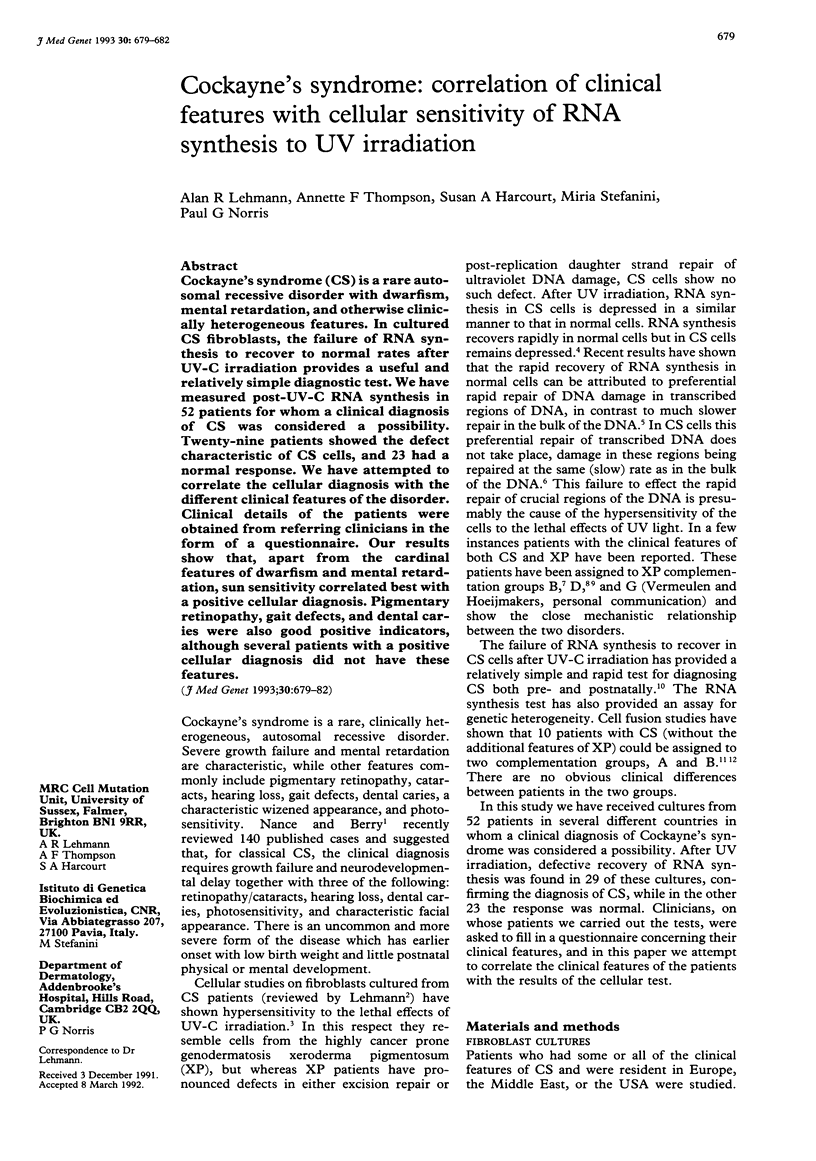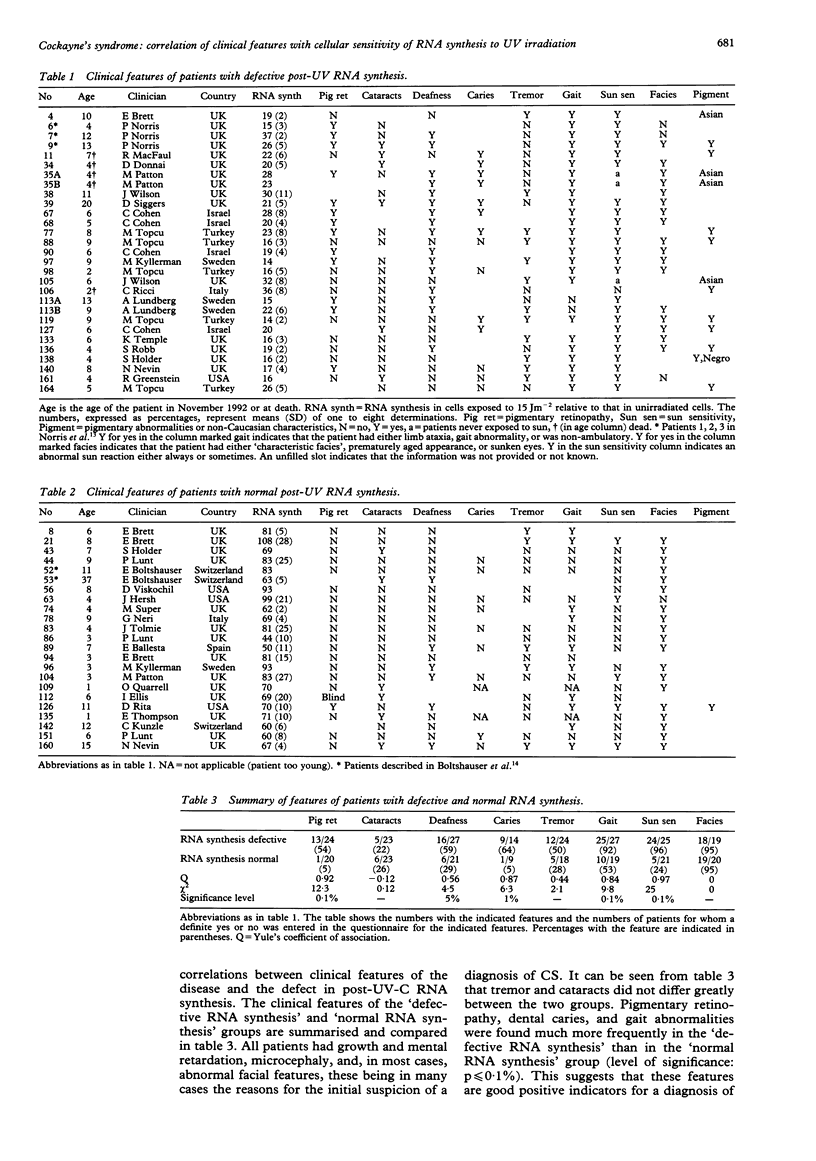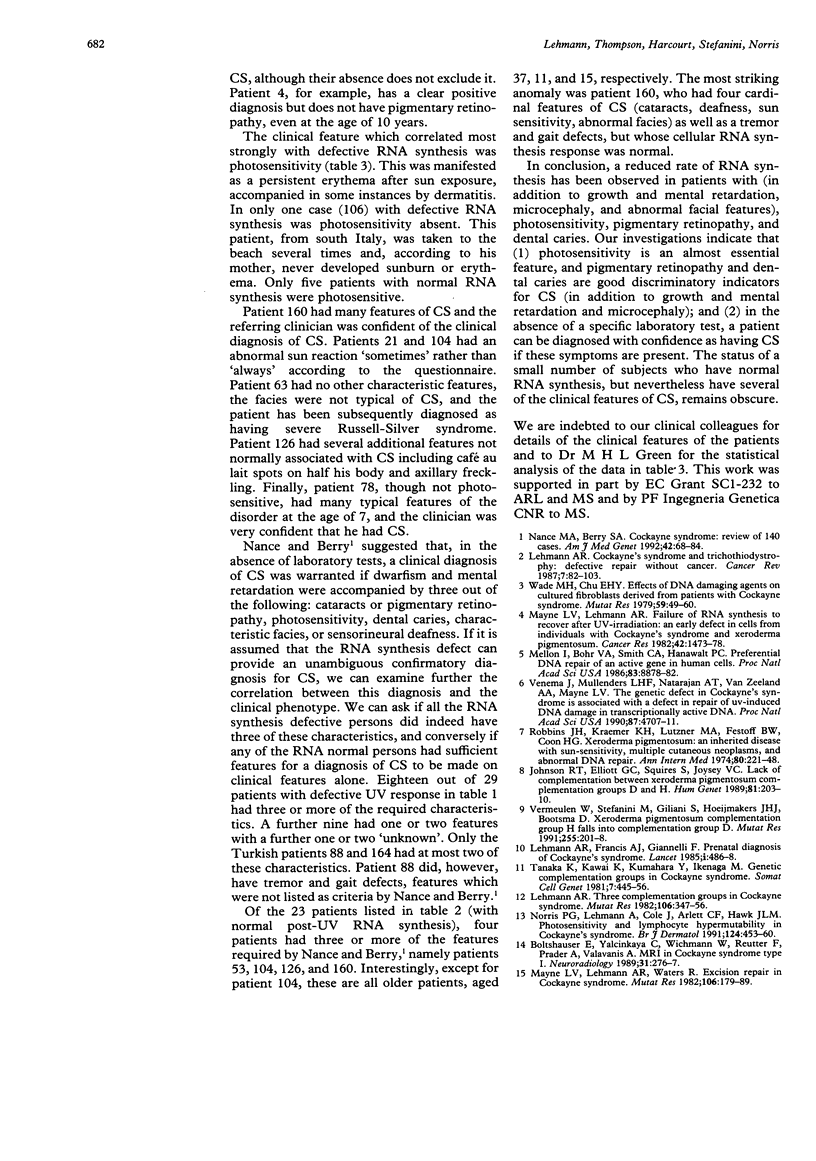Abstract
Cockayne's syndrome (CS) is a rare autosomal recessive disorder with dwarfism, mental retardation, and otherwise clinically heterogeneous features. In cultured CS fibroblasts, the failure of RNA synthesis to recover to normal rates after UV-C irradiation provides a useful and relatively simple diagnostic test. We have measured post-UV-C RNA synthesis in 52 patients for whom a clinical diagnosis of CS was considered a possibility. Twenty-nine patients showed the defect characteristic of CS cells, and 23 had a normal response. We have attempted to correlate the cellular diagnosis with the different clinical features of the disorder. Clinical details of the patients were obtained from referring clinicians in the form of a questionnaire. Our results show that, apart from the cardinal features of dwarfism and mental retardation, sun sensitivity correlated best with a positive cellular diagnosis. Pigmentary retinopathy, gait defects, and dental caries were also good positive indicators, although several patients with a positive cellular diagnosis did not have these features.
Full text
PDF



Selected References
These references are in PubMed. This may not be the complete list of references from this article.
- Boltshauser E., Yalcinkaya C., Wichmann W., Reutter F., Prader A., Valavanis A. MRI in Cockayne syndrome type I. Neuroradiology. 1989;31(3):276–277. doi: 10.1007/BF00344359. [DOI] [PubMed] [Google Scholar]
- Johnson R. T., Elliott G. C., Squires S., Joysey V. C. Lack of complementation between xeroderma pigmentosum complementation groups D and H. Hum Genet. 1989 Feb;81(3):203–210. doi: 10.1007/BF00278989. [DOI] [PubMed] [Google Scholar]
- Lehmann A. R., Francis A. J., Giannelli F. Prenatal diagnosis of Cockayne's syndrome. Lancet. 1985 Mar 2;1(8427):486–488. doi: 10.1016/s0140-6736(85)92088-4. [DOI] [PubMed] [Google Scholar]
- Lehmann A. R. Three complementation groups in Cockayne syndrome. Mutat Res. 1982 Dec;106(2):347–356. doi: 10.1016/0027-5107(82)90115-4. [DOI] [PubMed] [Google Scholar]
- Mayne L. V., Lehmann A. R. Failure of RNA synthesis to recover after UV irradiation: an early defect in cells from individuals with Cockayne's syndrome and xeroderma pigmentosum. Cancer Res. 1982 Apr;42(4):1473–1478. [PubMed] [Google Scholar]
- Mayne L. V., Lehmann A. R., Waters R. Excision repair in Cockayne syndrome. Mutat Res. 1982 Nov;106(1):179–189. doi: 10.1016/0027-5107(82)90200-7. [DOI] [PubMed] [Google Scholar]
- Mellon I., Bohr V. A., Smith C. A., Hanawalt P. C. Preferential DNA repair of an active gene in human cells. Proc Natl Acad Sci U S A. 1986 Dec;83(23):8878–8882. doi: 10.1073/pnas.83.23.8878. [DOI] [PMC free article] [PubMed] [Google Scholar]
- Nance M. A., Berry S. A. Cockayne syndrome: review of 140 cases. Am J Med Genet. 1992 Jan 1;42(1):68–84. doi: 10.1002/ajmg.1320420115. [DOI] [PubMed] [Google Scholar]
- Norris P. G., Arlett C. F., Cole J., Lehmann A. R., Hawk J. L. Abnormal erythemal response and elevated T lymphocyte HRPT mutant frequency in Cockayne's syndrome. Br J Dermatol. 1991 May;124(5):453–460. doi: 10.1111/j.1365-2133.1991.tb00625.x. [DOI] [PubMed] [Google Scholar]
- Robbins J. H., Kraemer K. H., Lutzner M. A., Festoff B. W., Coon H. G. Xeroderma pigmentosum. An inherited diseases with sun sensitivity, multiple cutaneous neoplasms, and abnormal DNA repair. Ann Intern Med. 1974 Feb;80(2):221–248. doi: 10.7326/0003-4819-80-2-221. [DOI] [PubMed] [Google Scholar]
- Tanaka K., Kawai K., Kumahara Y., Ikenaga M., Okada Y. Genetic complementation groups in cockayne syndrome. Somatic Cell Genet. 1981 Jul;7(4):445–455. doi: 10.1007/BF01542989. [DOI] [PubMed] [Google Scholar]
- Venema J., Mullenders L. H., Natarajan A. T., van Zeeland A. A., Mayne L. V. The genetic defect in Cockayne syndrome is associated with a defect in repair of UV-induced DNA damage in transcriptionally active DNA. Proc Natl Acad Sci U S A. 1990 Jun;87(12):4707–4711. doi: 10.1073/pnas.87.12.4707. [DOI] [PMC free article] [PubMed] [Google Scholar]
- Vermeulen W., Stefanini M., Giliani S., Hoeijmakers J. H., Bootsma D. Xeroderma pigmentosum complementation group H falls into complementation group D. Mutat Res. 1991 Sep;255(2):201–208. doi: 10.1016/0921-8777(91)90054-s. [DOI] [PubMed] [Google Scholar]


